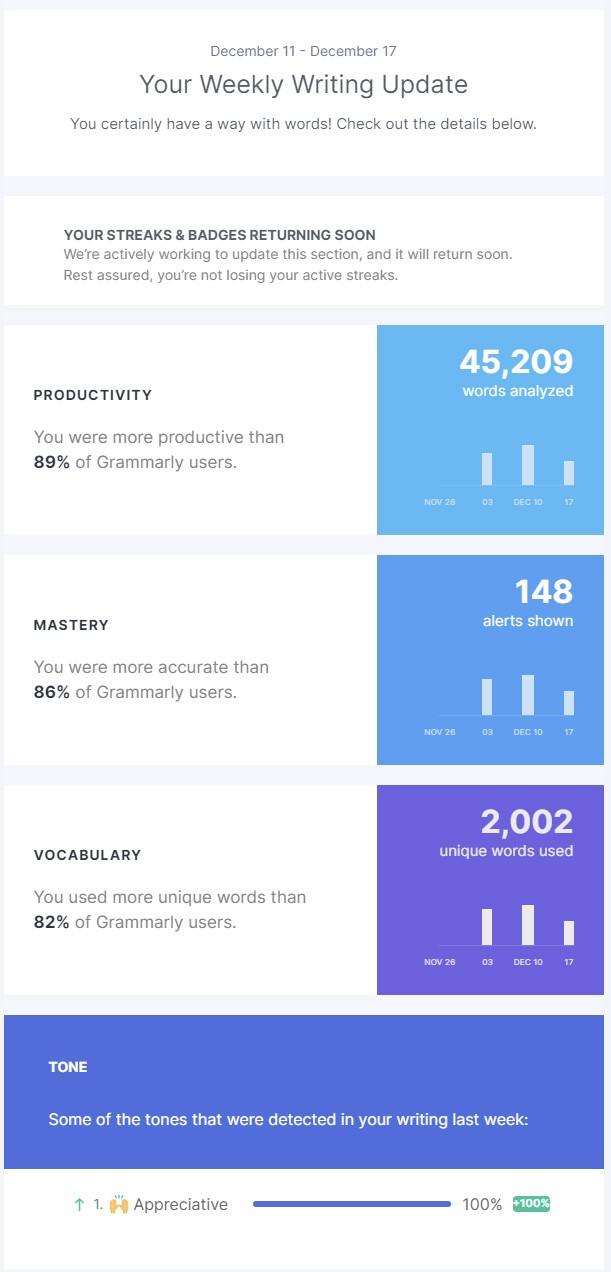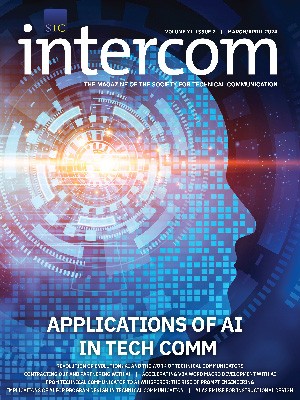By Thomas Barker | Fellow
Writing in 1998 in his book Tunesmith, well known songwriter Jimmy Webb speculated about artificial intelligence (AI) for writers. He wrote: “In fact, it [a rhyming program called A Zillion Kajillion Rhymes] will do just about everything (including the dishes) except write the song for you, and one of these days who knows? There may even be a program that will help you to do that as well” (p. 63).
For curiosity’s sake, I typed Webb’s paragraph into ChatGPT and asked it to write four lines, a verse of a song, based on the theme of the paragraph. Here goes:
In the realm of rhymes, where words unite,
A Zillion Kajillion, pure delight.
Multi-syllable whispers, a poetic flight,
Echoes of verses, in the soft moonlight.
Type in some ideas and out comes a verse: the writers’ dream…come true. Students must think so because they are increasingly using generative AI text in their research papers. Technical communicators have cashed in on the AI phenomenon using automated content generation. Is this a dream come true or just back to the future?
In this column, I explore the relationship between the work of technical communication scholars and technical communicators themselves and their tools. On the one hand, we have minds trained on the interactions of people and technology; and on the other, we have language tools that articulate how people use, mold, shape, and represent how they want to use technology.
This short journey will begin by looking at the dream: the tools themselves (dictionaries, lists, models, records, reports) and how we have used them over time. Snapshots will suffice because we’re not looking comprehensively at the phenomena of writing, but at specific examples. We will see the way these tools have changed over time. Next, I will explore what has not changed, what still confronts the writer and, I hope, the exciting challenges that we face—acting and doing, learning and reflecting—the challenges that arise when we find ourselves back to the future.
Looking Back: Automated Style Checking in the 1980s
What do we mean by writing tools? Of course, everyone could use pen and paper, typewriter and computer, dictionary and thesaurus, reports and scholarship. However, in the late 1970s, one of the first writing tools to analyze writing itself became available. Hello World: meet Grammatik (pronounced Grama-teek).
Flashback: In 1980 personal computing was un-networked, storage was limited to 5.25-inch floppy disks, all software came in boxes with documentation, and PCs had under 100KB of core memory. A “big” TRS-80 Model III had 48K bytes of memory.
It was a smaller, slower world for personal computers, but it was a faster world when you considered the pace of writing tools being developed. A review of Grammatik in InfoWorld magazine in December 1981 reported that the program analyzed a 1054-word document in 72 seconds. Ah – wow! The review lists the following features: a Flesch-Kinkaid readability index score and the ability to find repeated words, archaic usage, gender-specific words, and awkward or redundant phrases.
Most important, perhaps, is the ability to incorporate special dictionaries individual users can create to check technical jargon or foreign-language words or phrases. The program also provides utilities to create, sort and edit the dictionaries (Lowden 1981).
The ability to create custom dictionaries opened up vistas for me and my Computers and Writing colleagues in the 1980s. We emptied our minds into dictionaries and word lists with the hope of finding tell-tale shreds of clunky writing. For me and my student researchers, these features opened new possibilities for writers. Knowing the readability score can help you connect with readers about specific subjects. Poets using a rhyming dictionary, students writing reports, scholars discussing results: they all need to learn from tools as well as use them. We even wrote a computer program called COMMENT (using the BASIC language) to help students interpret their automated results (this work is archived in the Thomas Barker papers at the Southwest Collection at Texas Tech University).
What was the future back then? I remember thinking, what if I could get Grammatik to “read” (sift through for known or possible blunders) what I wrote every day: emails, reports, presentations, articles. I log on and it’s “Hi Tom, here are your writing stats for yesterday.” Word count, verb/noun ratio, average readability score, and whatever else I dial in using my Grammatik analysis tool. A daily diagnosis of my productivity, somewhat analogous to a Nutrition Facts Label for writing.
Automated Style Checking in 2024
Fast forward to 2024. The other day I got a message from Grammarly, the contemporary version of Grammatik. It’s not exactly what I had envisioned in the 1980s, but it comes close to qualifying as a back-to-the-future moment for me. There they are: my writing stats. It took over 40 years, but now the system looks at my productivity, grammar skill level, and vocabulary by processing my email text.

Programs like Grammarly are doing just what Jimmy Webb envisioned for many writing professionals. How does Grammarly work? Grammarly uses a large language model (LLM) to read massive amounts of text and develop predictions of words that probably make sense. Not only that, the dataset programming also cleans out low-quality data and teaches itself how to find characteristics of style, punctuation, and other text features. According to Wikipedia, Grammarly, “…reviews spelling, grammar, punctuation, clarity, engagement, and delivery mistakes in English texts, detects plagiarism, and suggests replacements for the identified errors. It also allows users to customize their style, tone, and context-specific language.”
How can AI help scholarly writers?
AI tools for writers can help with all aspects of scholarly writing. Some systems (Elicit.com) can assist with literature reviews and shaping theses, while others (Penelope.ai) can assist in the publication process. Here are some programs that specifically focus on writing.
- Writefull provides a host of tools and widgets to help with writing. Some products integrate with word processors, such as Word or Overleaf, while others focus on specific tasks such as revision and citation checking.
- QuillBot offers versions for specific writing environments (Chrome, Word, MacOS) and helps writers with grammar, possible plagiarism, citation management, and translation. This system focuses on all aspects of the writing process, from start of a new project to finish.
- WordTune is another writing assistance system that covers the process of writing. It offers help with rewriting, creating an effective style, providing templates and content development, and speeding up the writer’s reading and information processing tasks.
- Shorthand is a “storytelling platform for teams in marketing, communications, and media. This system focuses on developing web content. Not only does it facilitate content creation, but also it publishes and integrates content with various platforms.
- Anyword and Writesonic are designed for marketing writing and can also help the writer select social media channels and support branding.
- Scite is a writing assistant specifically for research writing. It can help with literature reviews and evidence finding from scholarly works. Additionally, Scite integrates with browsers and citation management platforms like Zotero.
- ChatGPT is the mother of all writing assistance platforms. ChatGPT is known to be the embodiment of the generative AI project of analyzing sampled text and using algorithms to process what it has learned into writing products, including software code. Of the tools I use, this is the most versatile and the easiest to apply to a specific writing problem a section of text. (55 words)
I asked ChatGPT to rewrite that last paragraph.
ChatGPT is the embodiment of a generative AI project that analyzes sampled text using algorithms to produce diverse writing outputs, including software code. Among the tools I use, it is the most versatile and easy to apply to specific writing challenges. (41 words)
I would call that an improvement. If I didn’t want to spend time revising the original (especially for wordiness) the revision would do nicely.
In the realm of writing assistance tools, not all are created alike. Some offer a comprehensive suite encompassing both writing tools and process management features. If your aim is solely to have an AI review your content, navigating through various features might be necessary. Many tools concentrate on web or marketing content, seamlessly integrating with writing teams. Specific AI assistance platforms cater to distinct channels like Instagram™ and Facebook™, tailoring their capabilities to recognized genres and forms, such as crafting product descriptions or shaping compelling story plots. Conveniently, most platforms facilitate access by allowing login through Google or other system credentials, ensuring ease of use across different devices.
Back to the future
This article began by looking at how a songwriter used rhyming dictionaries to help with writing. I’d like to return to that example. Songwriter Jimmy Webb tells how he looked up rhymes for “now” and found a list of 30 rhyming words. He then evaluated each one for suitability in the song he was writing and reduced the list to five possible candidates. The point for academic writers is to remember Webb’s engagement with the results from his “tool” The Complete Rhyming Dictionary, by Clement Wood.
We have looked at how automated writing and text analysis tools began by comparing writing samples with known dictionaries and providing rudimentary support for academic writers. We saw that current tools do something similar, but their “learning curve” covers trillions of words and can extract procedures for producing and revising text. A brief survey of writing tools available as of this writing showed that while these systems can help with wordsmithing, they also can assist in citation management, navigating the submission process, and revising for fit with a journal’s requirements.
I would like to suggest, however, that we follow the practice of someone like Jimmy Webb: use the tools that fit the situation. The best intelligence for writing, no matter the writer’s skill, is the writer’s own mind. Back in the 80s we finally gave up on using automated solutions because of their false positives—suggestions that didn’t really fit. We need to do so when we’re back to the future with generative AI suggestions.
References
Lowden, Bob. “Grammatik, a writing-style analyzer from Aspen.” InfoWorld 3, no. 1 (December 1981): 36.
Webb, Jimmy. Tunesmith: Inside the art of songwriting. Hyperion, 1998.
 Thomas Barker is Professor of Communication in the Graduate Program in Communication and Technology in the Faculty of Arts at the University of Alberta. His research focuses on communication issues in public health, risk communication, and higher education. He has published in software documentation, risk communication, and higher education.
Thomas Barker is Professor of Communication in the Graduate Program in Communication and Technology in the Faculty of Arts at the University of Alberta. His research focuses on communication issues in public health, risk communication, and higher education. He has published in software documentation, risk communication, and higher education.


